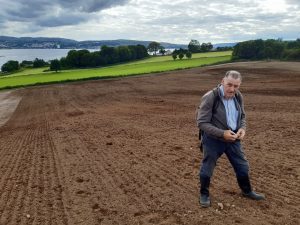Born 17th Nov 1946; Died 2nd August 2022

Tam Ward
By Ed Archer, Jim Ness, Dave Cowley and Trevor Cowie
Scottish archaeology lost one of its most colourful characters in August 2022 when Tam Ward died after a short battle with cancer. He had an interest in the past around him from a young age, an early indication of what would become an obsession that combined his fascination with archaeology, history and the landscapes around him. Trained as an electrician, his career included stints on North Sea oil rigs and platforms in a two weeks on/two weeks off pattern of working that he described as giving him a fortnight’s holiday every month! Never one to sit around, these ‘holiday’ weeks were put to good effect as he joined the Lanark and District Archaeology Society, became a driving force behind the Moat Park Heritage Centre in Biggar (now incorporated in the Museum of Biggar and Upper Clydesdale) and initiated excavation and survey projects in Lanarkshire.
There are not many aspects of the archaeology and history of Lanarkshire, and especially Clydesdale, that Tam did not investigate. He had an enduring interest in bastles, on which he undertook excavation and survey that raised awareness of these important, but poorly known, post-medieval buildings. His work made Tam painfully aware of the extent to which the built and buried heritage was under threat from ploughing, forestry, scouring by water courses, and erosion through fluctuating water levels in reservoirs. To better equip himself to deal with the many hundreds of unrecorded sites scattered across the hills, Tam completed the Glasgow University Certificate Course in Field Archaeology. He and a dedicated band of volunteers then set about exploring the landscape, recording many hundreds of sites that otherwise might have been destroyed through ignorance of their existence.
Many of these remains were post-medieval in date, such as ‘buchts’ or folds for dealing with sheep, but also included burnt mounds of Bronze Age and Early Medieval date and early lead smelting sites. In some cases, his survey work led to rescue excavations, notably around Daer Reservoir, where his fieldwork contributed much to the known evidence for Mesolithic populations in the Southern Uplands. The internationally important Upper Palaeolithic lithic assemblage from Howburn would never have become known but for Tam’s persistence in walking ploughed fields and drawing on his local knowledge to target areas that became available for inspection on a piecemeal basis.
Tam cared passionately about archaeology, inspiring others with that passion. The Young Archaeologists’ Club that he ran in Biggar for 20 years was popular, with four of its members going on to do archaeology degrees. He travelled extensively to talk to any group that was interested about his work, and drew on his experience setting up the Biggar Archaeology Group to encourage the formation of the Peeblesshire Archaeological Society. After moving to Rosneath he founded the North Clyde Archaeological Society in 2013, stimulating work on a range of sites from the Bronze Age to the Second World War.
It is fair to say that Tam had a mixed relationship with the archaeological profession of which he was persistently critical, certainly sometimes fairly, other times perhaps not, but always motivated by a passion for the past. He was frustrated by what he saw as official inertia in responding to the impacts of changing land use, for example, and sometimes disappointed in a perceived lack of interest amongst the archaeological community in the work being done. Very much his own man with strong opinions, his strength of personality usually stood him in good stead. It sometimes made him challenging company. Nevertheless, Tam secured several jobs in archaeology, including directing a Manpower Services team at Summerlee in Coatbridge. He served as the Archaeological Projects Officer on the M74 upgrade, worked as an Assistant Curator at the National Museum of Scotland and produced a book on the Ancient Monuments of Clydesdale for Clydesdale District Council. His job at the National Museum involved the rehousing of much of the archaeological collection from its former home in Queen Street to what were then new storage facilities in Leith, a task he felt enormously privileged to have done.
Tam won awards and recognition for his work, including the inaugural Dorothy Marshall Award from the Society of Antiquaries of Scotland, an honour he accepted on behalf of the Biggar Archaeology Group, since, in his words, ‘no man stands alone’. He received an MBE in 2001 for his services to archaeology in Lanarkshire, a well-deserved accolade for a lifetime bringing the past to the present.
Tam had an enormous impact on archaeology and cared passionately about passing that on. The ‘Simulated Dig’ that Tam and the Biggar Group delivered for the 1990 Glasgow City of Culture event went on to be experienced by more than 4500 children over subsequent years, including in every village in Upper Clydesdale. While his recording and excavation works are themselves a significant legacy, his ability to engage others and enthuse them about the past is less tangible but no less important.
The Biggar Archaeology Group website contains links to his work and includes an autobiography. Tam is survived by his second wife Sandra, children Tammy, Stewart and Steven and ‘the magnificent’ seven granddaughters.
Help us: champion research; stimulate discussion; enhance public understanding; and share our extraordinary heritage. Donate directly to the Society now.